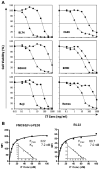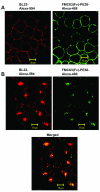Differential cellular internalization of anti-CD19 and -CD22 immunotoxins results in different cytotoxic activity
- PMID: 18676854
- PMCID: PMC2561922
- DOI: 10.1158/0008-5472.CAN-08-0461
Differential cellular internalization of anti-CD19 and -CD22 immunotoxins results in different cytotoxic activity
Abstract
B-cell malignancies routinely express surface antigens CD19 and CD22. Immunotoxins against both antigens have been evaluated, and the immunotoxins targeting CD22 are more active. To understand this disparity in cytotoxicity and guide the screening of therapeutic targets, we compared two immunotoxins, FMC63(Fv)-PE38-targeting CD19 and RFB4(Fv)-PE38 (BL22)-targeting CD22. Six lymphoma cell lines have 4- to 9-fold more binding sites per cell for CD19 than for CD22, but BL22 is 4- to 140-fold more active than FMC63(Fv)-PE38, although they have a similar cell binding affinity (Kd, approximately 7 nmol/L). In 1 hour, large amounts of BL22 are internalized (2- to 3-fold more than the number of CD22 molecules on the cell surface), whereas only 5.2% to 16.6% of surface-bound FMC63(Fv)-PE38 is internalized. The intracellular reservoir of CD22 decreases greatly after immunotoxin internalization, indicating that it contributes to the uptake of BL22. Treatment of cells with cycloheximide does not reduce the internalization of BL22. Both internalized immunotoxins are located in the same vesicles. Our results show that the rapid internalization of large amounts of BL22 bound to CD22 makes CD22 a better therapeutic target than CD19 for immunotoxins and probably for other immunoconjugates that act inside cells.
Figures




Similar articles
-
Anti-CD22 immunotoxin RFB4(dsFv)-PE38 (BL22) for CD22-positive hematologic malignancies of childhood: preclinical studies and phase I clinical trial.Clin Cancer Res. 2010 Mar 15;16(6):1894-903. doi: 10.1158/1078-0432.CCR-09-2980. Epub 2010 Mar 9. Clin Cancer Res. 2010. PMID: 20215554 Free PMC article. Clinical Trial.
-
The cytotoxicity of anti-CD22 immunotoxin is enhanced by bryostatin 1 in B-cell lymphomas through CD22 upregulation and PKC-βII depletion.Haematologica. 2012 May;97(5):771-9. doi: 10.3324/haematol.2011.049155. Epub 2011 Dec 16. Haematologica. 2012. PMID: 22180432 Free PMC article.
-
Cytotoxic activity of disulfide-stabilized recombinant immunotoxin RFB4(dsFv)-PE38 (BL22) toward fresh malignant cells from patients with B-cell leukemias.Clin Cancer Res. 2000 Apr;6(4):1476-87. Clin Cancer Res. 2000. PMID: 10778980
-
Technology evaluation: BL22, NCI.Curr Opin Mol Ther. 2002 Feb;4(1):72-5. Curr Opin Mol Ther. 2002. PMID: 11883697 Review.
-
Antibody fusion proteins: anti-CD22 recombinant immunotoxin moxetumomab pasudotox.Clin Cancer Res. 2011 Oct 15;17(20):6398-405. doi: 10.1158/1078-0432.CCR-11-0487. Clin Cancer Res. 2011. PMID: 22003067 Free PMC article. Review.
Cited by
-
Production of unique immunotoxin cancer therapeutics in algal chloroplasts.Proc Natl Acad Sci U S A. 2013 Jan 2;110(1):E15-22. doi: 10.1073/pnas.1214638110. Epub 2012 Dec 10. Proc Natl Acad Sci U S A. 2013. PMID: 23236148 Free PMC article.
-
Novel CD7-specific nanobody-based immunotoxins potently enhanced apoptosis of CD7-positive malignant cells.Oncotarget. 2016 Jun 7;7(23):34070-83. doi: 10.18632/oncotarget.8710. Oncotarget. 2016. PMID: 27083001 Free PMC article.
-
A BAFF ligand-based CAR-T cell targeting three receptors and multiple B cell cancers.Nat Commun. 2022 Jan 11;13(1):217. doi: 10.1038/s41467-021-27853-w. Nat Commun. 2022. PMID: 35017485 Free PMC article.
-
Diagnosis and treatment of hairy cell leukemia as the COVID-19 pandemic continues.Blood Rev. 2022 Jan;51:100888. doi: 10.1016/j.blre.2021.100888. Epub 2021 Sep 4. Blood Rev. 2022. PMID: 34535326 Free PMC article. Review.
-
Identification and characterization of fully human anti-CD22 monoclonal antibodies.MAbs. 2009 May-Jun;1(3):297-303. doi: 10.4161/mabs.1.3.8113. Epub 2009 May 5. MAbs. 2009. PMID: 20065646 Free PMC article.
References
-
- Schwartz RS. Paul Ehrlich’s magic bullets. N Engl J Med. 2004;350:1079–80. - PubMed
-
- Adams GP, Weiner LM. Monoclonal antibody therapy of cancer. Nat Biotechnol. 2005;23:1147–57. - PubMed
-
- Wu AM, Senter PD. Arming antibodies: prospects and challenges for immunoconjugates. Nat Biotechnol. 2005;23:1137–46. - PubMed
-
- Nadler LM, Reinherz EL, Haynes BF, Bernstein ID, editors. B-cell/leukemia panel workshop: summary and comments. Springer-Verlag; New York: 1986. Leukocyte typing II; p. 3.
-
- Sato S, Tedder TF, Kishimoto T, et al., editors. White cell differentiation antigens. 6th edition Garland Publishing; New York: 1999. BC3, CD19 workshop panel report. leukocyte typing VI; pp. 133–4.
Publication types
MeSH terms
Substances
Grants and funding
LinkOut - more resources
Full Text Sources
Other Literature Sources

